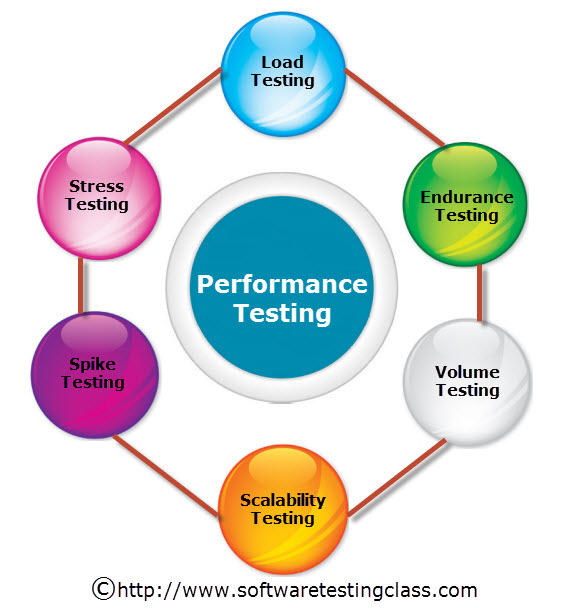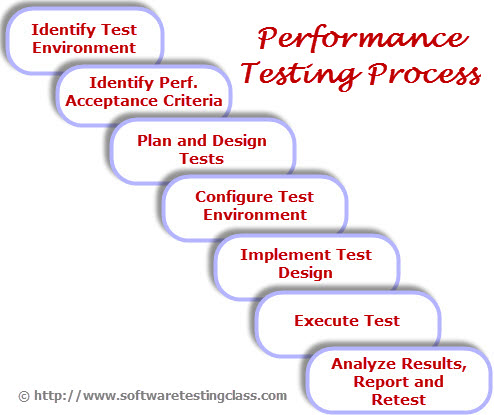Software Performance testing is type of testing perform to determine the performance of system to major the measure, validate or verify quality attributes of the system like responsiveness, Speed, Scalability, Stability under variety of load conditions. The system is tested under a mixture of load conditions and check the time required responding by the system under varying workloads. Software performance testing involves the testing of application under test to ensure that application is working as expected under variety of load conditions. The goal of performance testing is not only find the bugs in the system but also eliminate the performance bottlenecks from the system.
Why do performance testing?
Before going live in the market, the software system should be tested against the Speed, Stability and scalability under variety of load conditions. If system goes live without doing performance testing may cause the issues like running system slow while simultaneously accessing system by several users, poor usability which likely to gain the bad reputation and it affects the expected sales goal directly. Performance testing encompasses a range of different tests which enable analysis of various aspects of the system. The Performance testing is tells about what needs to fix before going live (mainly the issues faced under the variety of load conditions).
Types of Performance Testing:
1) Load Testing:
Load Testing is type of performance testing to check system with constantly increasing the load on the system until the time load is reaches to its threshold value. Here Increasing load means increasing number of concurrent users, transactions & check the behavior of application under test. It is normally carried out underneath controlled environment in order to distinguish between two different systems. It is also called as “Endurance testing” and “Volume testing”. The main purpose of load testing is to monitor the response time and staying power of application when system is performing well under heavy load. Load testing comes under the Non Functional Testing & it is designed to test the non-functional requirements of a software application.
Load testing is perform to make sure that what amount of load can be withstand the application under test. The successfully executed load testing is only if the specified test cases are executed without any error in allocated time.
Simple examples of load testing:
- Testing printer by sending large job.
- Editing a very large document for testing of word processor
- Continuously reading and writing data into hard disk.
- Running multiple applications simultaneously on server.
- Testing of mail server by accessing thousands of mailboxes
- In case of zero-volume testing & system fed with zero load.
2) Stress Testing:
Stress Testing is performance testing type to check the stability of software when hardware resources are not sufficient like CPU, memory, disk space etc.
“To determine or validate an application’s behavior when it is pushed beyond normal or peak load conditions.”
Stress testing is Negative testing where we load the software with large number of concurrent users/processes which cannot be handled by the systems hardware resources. This testing is also known as Fatigue testing, this testing should capture the stability of the application by testing it beyond its bandwidth capacity.
The main idea behind stress testing is to determine the failure of system and to keep an eye on how the system gracefully get recover back, this quality is known as recoverability. Stress testing comes under the Non Functional Testing & it is designed to test the non-functional requirements of a software application. This testing is to be carried out under controlled environment before launch, so that we can accurately capture the system behavior under most erratic scenarios
3) Spike testing:
Spike testing is subset of Stress Testing. A spike test is carried out to validate the performance characteristics when the system under test subjected to workload models and load volumes that repeatedly increase beyond anticipated production operations for short periods of time.
4) Endurance testing:
Endurance testing is a non functional type of testing. Endurance testing involves testing a system with a expected amount of load over a long period of time to find the behavior of system. Let’s take a example where system is designed to work for 3 hrs of time but same system endure for 6 hrs of time to check the staying power of system. Most commonly test cases are executed to check the behavior of system like memory leaks or system fails or random behavior. Sometimes endurance testing is also referred as Soak testing.
5) Scalability Testing:
Scalability Testing is type of non-functional tests and it is the testing of a software application for determine its capability to scale up in terms of any of its non-functional capability like the user load supported, the number of transactions, the data volume etc. The main aim if this testing is to understand at what peak the system prevent more scaling.
6) Volume testing:
Volume testing is non-functional testing which refers to testing a software application with a large amount of data to be processed to check the efficiency of the application. The main goal of this testing is to monitor the performance of application under varying database volumes.
Top Performance Testing Tools:
- WebLOAD
- LoadRunner
- Apache JMeter
- NeoLoad
- LoadUI
- OpenSTA
- WAPT
- LoadImpact
- Loadster
- Httperf
- Rational Performance Tester
- QEngine (ManageEngine)
- Testing Anywhere
- CloudTest
- Loadstorm
Performance Testing Process:
The following sections discuss the seven activities that most commonly occur across successful performance-testing projects.
Below is a generic performance testing process
1) Identify your testing environment –
Do proper requirement study & analyzing test goals and its objectives. Also determine the testing scope along with test Initiation Checklist. Identify the logical and physical production architecture for performance testing, identify the software, hardware and networks configurations required for kick off the performance testing. Compare the both test and production environments while identifying the testing environment. Get resolve the environment-related concerns if any, analyze that whether additional tools are required for performance testing. This step also helps to identify the probable challenges tester may face while performance testing.
2) Identify the performance acceptance criteria –
Identify the desired performance characteristics of the application like Response time, Throughput and Resource utilization.
3) Plan & design performance tests –
Planning and designing performance tests involves identifying key usage scenarios, determining appropriate variability across users, identifying and generating test data, and specifying the metrics to be collected. Ultimately, these items will provide the foundation for workloads and workload profiles. The output of this stage is prerequisites for Test execution are ready, all required resources, tools & test data are ready.
4) Configuring the test environment –
Prepare with conceptual strategy, available tools, designed tests along with testing environment before execution. The output of this stage is configured load-generation environment and resource-monitoring tools.
5) Implement test design –
According to test planning and design create your performance tests.
6) Execute the tests –
- Collect and analyze the data.
- Problem Investigation like bottlenecks (memory, disk, processor, process, cache, network, etc.) resource usage like (memory, CPU, network, etc.,)
- Generate the Performance analysis reports containing all performance attributes of the application.
- Based on the analysis prepare recommendation report.
- Repeat the above test for the new build received from client after fixing the bugs and implementing the recommendations
7) Analyze Results, Report, and Retest
Consolidate, analyze and share test results.
Based on the test report re-prioritize the test & re-execute the same. If any specific test result within the specified metric limit & all results are between the thresholds limits then testing of same scenario on particular configuration is completed.
Common Performance Problems:
In the software testing of an application Speed is one of the important attribute. User will not happy to work with slow system. The performance testing uncovers the performance bottlenecks & defects to maintain interest and attention of user. Here is the list of most commonly performance problems observed in software system:
- Poor response time
- Long Load time
- Bottlenecking
- Poor scalability
- Software configuration issues (for the Web server, load balancers, databases etc.)
- Disk usage
- Operating System limitations
- Poor network configuration
- Memory utilization
- CPU utilization
- Insufficient hardware resources
Conclusion:
For the success of Software system Performance testing plays a key role software testing life cycle. It makes certain the customer satisfaction & elements the risk of product failure. So it very much important to carry out the Performance testing before goes live in the market.
I think I have addressed all major Performance testing points. I have worked for around 1.5 years out of my testing career on performance testing. There are some experts who have spent their whole career life on Performance testing. If I missed out addressing some important around performance testing aspect then let me know in comments below.
Let me know if you are using any other performance testing tool that I need to mention here.
Happy Testing!!!
Don’t Miss Another Article
Join over 10,000 people who get FREE and fresh content from this Blog. We Respect Privacy, You’re Safe! No Spam!
- Elements of JMeter
- How to do Performance Testing using JMeter? – JMeter Tutorials Series Day 5
- Best Practices from JMeter – JMeter Tutorials Series Day 11
- Overview Of Performance Testing With VSTS
- How to create web performance test with VSTS?
- Performance Testing vs Load Testing vs Stress Testing
- What Is Endurance Testing In Software Testing?
- Tutorial 1: Introduction to Apache JMeter
- JMeter’s Distributed Testing – JMeter Tutorials Series Day 10
- Concurrency Testing: Challenges, Techniques & Process



13 thoughts on “What is Performance Testing?”
Very nice article on Performance Testing, simple explanation with easy to understand examples. Very good help for all especially for the beginners.
very good example.provide few more for better understanding and ease.
Thank you very much, this Performance testing article really help for us.
Thanks for this bright explaination
Excellent explanation between the Performance terms & the performance testing process.
Simply nice and clear :)
Hi friends..
Currently I am working in telecom testing (non-IT), i would like to make my career in Software Testing, please can some guide me how I can proceed further
Thank you
Charu Roy
I am new in software testing field, can someone tell me “is there any special role for Performance testing, or normal tester can do the Performance testing?
-Sweta Soni
Which tool should be best in the above listed tools in the article?
I actually appreciate the material you have on your web site it extremely has helped me out a whole lot thanks
what is integration testing any body please help me?
Very helpful.. Thanks
topics on hp load runner please